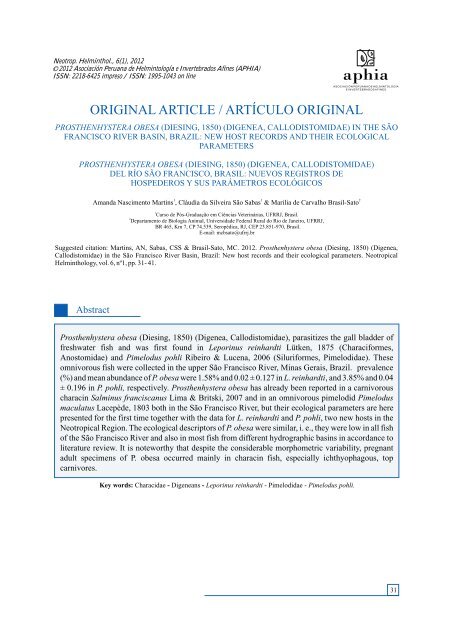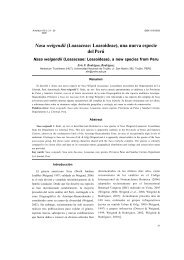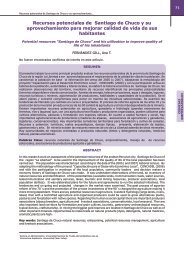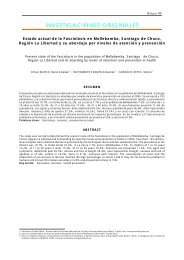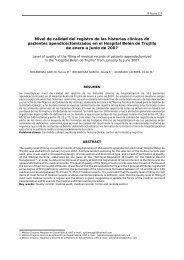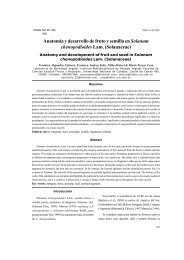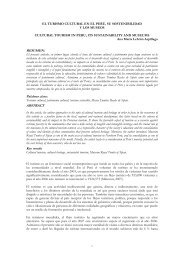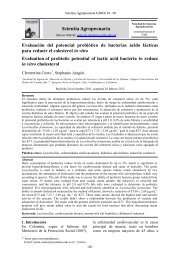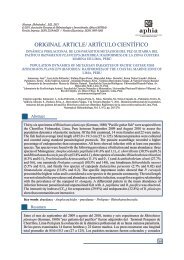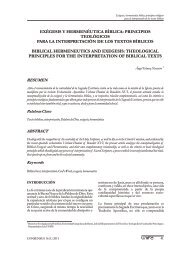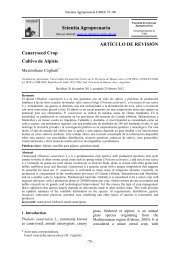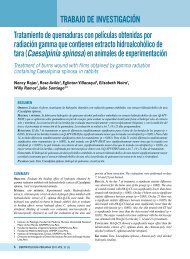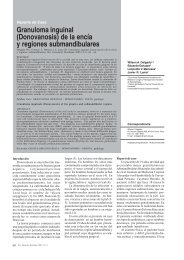neotropical vol. 6 - Portal del Sistema de Bibliotecas de la UNMSM
neotropical vol. 6 - Portal del Sistema de Bibliotecas de la UNMSM
neotropical vol. 6 - Portal del Sistema de Bibliotecas de la UNMSM
Create successful ePaper yourself
Turn your PDF publications into a flip-book with our unique Google optimized e-Paper software.
Neotrop. Helminthol., 6(1), 20122012 Asociación Peruana <strong>de</strong> Helmintología e Invertebrados Afines (APHIA)ISSN: 2218-6425 impreso / ISSN: 1995-1043 on lineORIGINAL ARTICLE / ARTÍCULO ORIGINALPROSTHENHYSTERA OBESA (DIESING, 1850) (DIGENEA, CALLODISTOMIDAE) IN THE SÃOFRANCISCO RIVER BASIN, BRAZIL: NEW HOST RECORDS AND THEIR ECOLOGICALPARAMETERSPROSTHENHYSTERA OBESA (DIESING, 1850) (DIGENEA, CALLODISTOMIDAE)DEL RÍO SÃO FRANCISCO, BRASIL: NUEVOS REGISTROS DEHOSPEDEROS Y SUS PARÁMETROS ECOLÓGICOS1 1 2Amanda Nascimento Martins , Cláudia da Silveira São Sabas & Marilia <strong>de</strong> Carvalho Brasil-Sato1Curso <strong>de</strong> Pós-Graduação em Ciências Veterinárias, UFRRJ, Brasil.2Departamento <strong>de</strong> Biologia Animal, Universida<strong>de</strong> Fe<strong>de</strong>ral Rural do Rio <strong>de</strong> Janeiro, UFRRJ,BR 465, Km 7, CP 74.539, Seropédica, RJ, CEP 23.851-970, Brasil.E-mail: mcbsato@ufrrj.brSuggested citation: Martins, AN, Sabas, CSS & Brasil-Sato, MC. 2012. Prosthenhystera obesa (Diesing, 1850) (Digenea,Callodistomidae) in the São Francisco River Basin, Brazil: New host records and their ecological parameters. NeotropicalHelminthology, <strong>vol</strong>. 6, nº1, pp. 31- 41.AbstractProsthenhystera obesa (Diesing, 1850) (Digenea, Callodistomidae), parasitizes the gall b<strong>la</strong>d<strong>de</strong>r offreshwater fish and was first found in Leporinus reinhardti Lütken, 1875 (Characiformes,Anostomidae) and Pimelodus pohli Ribeiro & Lucena, 2006 (Siluriformes, Pimelodidae). Theseomnivorous fish were collected in the upper São Francisco River, Minas Gerais, Brazil. prevalence(%) and mean abundance of P. obesa were 1.58% and 0.02 ± 0.127 in L. reinhardti, and 3.85% and 0.04± 0.196 in P. pohli, respectively. Prosthenhystera obesa has already been reported in a carnivorouscharacin Salminus franciscanus Lima & Britski, 2007 and in an omnivorous pimelodid Pimelodusmacu<strong>la</strong>tus Lacepè<strong>de</strong>, 1803 both in the São Francisco River, but their ecological parameters are herepresented for the first time together with the data for L. reinhardti and P. pohli, two new hosts in theNeotropical Region. The ecological <strong>de</strong>scriptors of P. obesa were simi<strong>la</strong>r, i. e., they were low in all fishof the São Francisco River and also in most fish from different hydrographic basins in accordance toliterature review. It is noteworthy that <strong>de</strong>spite the consi<strong>de</strong>rable morphometric variability, pregnantadult specimens of P. obesa occurred mainly in characin fish, especially ichthyophagous, topcarnivores.Key words: Characidae - Digeneans - Leporinus reinhardti - Pimelodidae - Pimelodus pohli.31
New host records of Prosthenhystera obesaMartins et al.ResumenProsthenhystera obesa (Diesing, 1850) (Digenea, Callodistomidae) parasita <strong>la</strong> vesícu<strong>la</strong> biliar <strong>de</strong> lospeces <strong>de</strong> agua dulce y se encontró por primera vez en Leporinus reinhardti Lütken, 1875(Characiformes, Anostomidae) y en Pimelodus pohli Ribeiro & Lucena, 2006 (Siluriformes,Pimelodidae). Estos peces omnívoros se colectaron en <strong>la</strong> parte alta <strong><strong>de</strong>l</strong> río São Francisco, MinasGerais, Brasil. La prevalencia (%) y abundancia media <strong><strong>de</strong>l</strong> parasitismo por P. obesa fue 1,58% y 0,02 ±0,12 en L. reinhardti, y 3,85% y 0,04 ± 0,19 en P. pohli, respectivamente. Prosthenhystera obesa ya hasido registrado en un carnívoro characido Salminus franciscanus Lima & Britski, 2007 y en unomnívoro pimelódido Pimelodus macu<strong>la</strong>tus Lacepè<strong>de</strong>, 1803, los dos <strong><strong>de</strong>l</strong> río São Francisco, pero susparámetros ecológicos son presentados aquí por primera vez junto con los datos <strong>de</strong> L. reinhardti y P.pohli, dos nuevos hospe<strong>de</strong>ros <strong>de</strong> <strong>la</strong> región Neotropical. Los <strong>de</strong>scriptores ecológicos <strong>de</strong> P. obesa fueronsimi<strong>la</strong>res, en otras pa<strong>la</strong>bras, fueron bajos en todos los peces <strong><strong>de</strong>l</strong> río São Francisco y también en <strong>la</strong>mayoría <strong>de</strong> los peces <strong>de</strong> diferentes cuencas hidrográficas, <strong>de</strong> acuerdo con <strong>la</strong> revisión <strong>de</strong> <strong>la</strong> literatura. Se<strong>de</strong>staca que a pesar <strong>de</strong> <strong>la</strong> variabilidad morfométrica <strong>de</strong> P. obesa, los especímenes adultos con huevos seencuentran principalmente en los peces characidos, en particu<strong>la</strong>r en los ictiófagos, carnívorossuperiores <strong>de</strong> <strong>la</strong> ca<strong>de</strong>na alimentaria.Pa<strong>la</strong>bras c<strong>la</strong>ve: Characidae - Digeneos - Leporinus reinhardti - Pimelodidae - Pimelodus pohli.INTRODUCTIONDiesing (1850) <strong>de</strong>scribed Distomum obesum fromgall b<strong>la</strong>d<strong>de</strong>rs of Salminus brevi<strong>de</strong>ns, Leporinusfri<strong>de</strong>rici and Xiphostoma cuvieri collected byJohann Natterer during his expedition in Brazil inthe early eighteenth century (between 1817 and1835) along with several specimens sent and<strong>de</strong>posited in the Museum Caesareae, Vienna,Austria (“Naturhistorischen Museum”). InDiesing (1855) information about D. obesum wasthe same, but the localities and the date ofcollection for these hosts were specified: S.brevi<strong>de</strong>ns (= Salminus brasiliensis (Cuvier, 1816)according Géry & Lauzanne (1990); cited as“Salmo Nr. 9”, p. 9, and Salmini brevi<strong>de</strong>ntis too,Fig. 11-13, in the Table III, p. 12), from Cuyaba(State of Mato Grosso) in 26, 29 November 1824;L. fri<strong>de</strong>rici (Bloch, 1794) from Mato Grosso (citedas “Piaba” too, p. 9), in 30 October 1826, and X.cuvieri (= Boulengerel<strong>la</strong> cuvieri (Spix & Agassiz,1829) according Vari (2003); cited as “SalmoPirapucu” too, p. 9), from Rio Branco (river ofState of Roraima, inclu<strong>de</strong>d by the authors), in 5June 1832.Travassos (1920) proposed Callodistomidae andProsthenhystera allocating D. obesum in it, as<strong>de</strong>scribed by Travassos (1922a) from specimenscollected of S. brevi<strong>de</strong>ns (= Salminus franciscanusLima & Britski, 2007 according to Lima & Britski(2007)) from Lassance, Minas Gerais, in the SãoFrancisco River.The morphometric variability of specimens ofProsthenhystera obesa (Diesing, 1850) fromseveral hosts was presented by Kohn et al. (1997).Despite this morphological investigation,Callodistomidae was consi<strong>de</strong>red enigmatic andinclu<strong>de</strong>d by Bray (2002) in Gymnophalloi<strong>de</strong>a,because of taxonomic convenience based onmorphological analysis of adults. Callodistomidaewas relocated in Gorgo<strong>de</strong>roi<strong>de</strong>a, Subor<strong>de</strong>rXiphidiata by Olson et al. (2003) amongP<strong>la</strong>giorchiida, after analysis of gene sequences ofsmaller ribosomal subunits of nucleic acids and32
Neotrop. Helminthol., 6(1), 2012because the cercariae have stylets to penetrate theintermediate host. According to Olson et al.(2003), representatives of Gorgo<strong>de</strong>roi<strong>de</strong>a in<strong>vol</strong>vea wi<strong>de</strong> variety of hosts, that is, using aquaticmolluscs whose <strong>la</strong>rvae can e<strong>vol</strong>ve in terrestrialtetrapods in their cycles and can use terrestrialhosts in the entire vital cycle. Families exclusivelyparasites of fish and Brachyc<strong>la</strong>didae were locatedIn Allocreadioi<strong>de</strong>a, whose species parasitizemarine mammals. Recently, Petkevičiūtė &Stanevičiūtė (2008), combining morphologica<strong>la</strong>nd molecu<strong>la</strong>r data of adult specimens and the<strong>la</strong>rval characters of various species avai<strong>la</strong>ble(Curran et al., 2006; Choudhury et al., 2007) with akaryotype analysis of three species located in theAllocreadiidae intramolluscan stage common inthe Palearctic region, suggested highere<strong>vol</strong>utionary simi<strong>la</strong>rity between Allocreadiidaeand Callodistomidae and Gorgo<strong>de</strong>ridae(Gorgo<strong>de</strong>roi<strong>de</strong>a) than Allocreadiidae andOpecoelidae, currently p<strong>la</strong>ced in Allocreadioi<strong>de</strong>a.These authors pointed out that the karyotypeanalysis of species will assist in interpreting there<strong>la</strong>tionships between families and genera of thesedigeneans.The unknown life cycle of the species inCallodistomidae and ignorance of the life historyof P. obesa, with the exception that the specimensin the adult stage parasitize the gall b<strong>la</strong>d<strong>de</strong>rs offreshwater fish, provi<strong>de</strong>d motivation for furtherinvestigations on P. obesa parasitism in freshwaterfish. Besi<strong>de</strong>s the uniqueness of parasitism by thesehosts, according to Pavanelli et al. (1992),pathology caused in fish would occur by gallb<strong>la</strong>d<strong>de</strong>r rupture with reduced capacity for storageof bile by the host and possible intake of hematinpigments by the parasite.According to the records P. obesa has a wi<strong>de</strong>distribution in Characiformes in Brazil:Characidae - Salminus maxillosus (= Salminusbrasiliensis (Cuvier, 1816) according Vari (2003),by Travassos (1922a) and Isaac et al. (2000),Salminus hi<strong>la</strong>rii Cuvier & Valenciennes (= S.hi<strong>la</strong>rii Valenciennes, 1850) by Kohn et al. (1997),Astyanax bimacu<strong>la</strong>tus (Linnaeus, 1758) andAstyanax fasciatus (Cuvier, 1819) by Travassos &Freitas (1941), Galeocharax humeralis(Valenciennes, 1834) by Travassos & Kohn(1965), Brycon sp., Cynopotamus amazonum(Günther, 1868) and Caranx gibbosus (Linnaeus)and Triurobrycon lundii Reinhardt by Kohn et al.(1997), <strong>la</strong>ter nominal taxa not found in FishBase;Cichlidae – Cich<strong>la</strong>soma bimacu<strong>la</strong>tum Linnaeus,1758 by Travassos (1940); Anostomidae -Leporinus sp. by Travassos (1922b), Leporinuscope<strong>la</strong>ndii Steindachner, 1875 by Travassos &Kohn (1965) and Leporellus vittatus(Valenciennes, 1850) by Kohn et al. (1997);Sciaenidae - Pachyurus squamipinnis (sic) (=Pachyurus squamipennis Agassiz, 1831) by Kohnet al. (1997); and in Siluriformes: Pimelodidae -Pseudopimelodus zungaro (Humboldt, 1821) byTravassos (1922a) and Travassos et al. (1928),Pseudopimelodus roosevelti (= Pseudop<strong>la</strong>tystomamangurus (Valenciennes, 1835) by Travassos et al.(1928), Pimelodus c<strong>la</strong>rias Linnaeus (probablyPimelodus c<strong>la</strong>rias macu<strong>la</strong>tus, a junior synonymyof P. macu<strong>la</strong>tus Lacepè<strong>de</strong>, 1803 according toFishBase) and Pimelodus fuer (sic) [= Pimelodusfur (Lütken, 1874)] by Travassos et al. (1928) andTravassos (1940), respectively. In the SãoFrancisco River basin, P. obesa was recor<strong>de</strong>d inAcestrorhamphus sp. by Travassos (1922a),Salminus brevi<strong>de</strong>ns [= S. franciscanus accordingLima & Britski (2007)] by Travassos (1922b),Pseudop<strong>la</strong>tystoma corruscans (Spix & Agassiz,1829) by Kohn et al. (1997), Salminus brasiliensis[= S. franciscanus according Lima & Britski(2007)] by Brasil-Sato (2002) and P. macu<strong>la</strong>tus byBrasil-Sato & Pavanelli (2004).Several species of fish from the upper SãoFrancisco River, Minas Gerais, Brazil, had theirendoparasitic fauna recently investigated:Characiformes, Characidae - Salminusfranciscanus by Brasil-Sato (2002), Myleusmicans (Lütken, 1875) by Brasil-Sato & Santos(2003), Serrasalmus brandtii Lütken, 1875 andPygocentrus piraya (Cuvier, 1819) by Santos(2008), Tetragonopterus chalceus Spix & Agassiz,1829 and Triportheus guentheri (Garman, 1890)by Albuquerque (2009); Doradidae -Franciscodoras marmoratus (Lütken, 1874) bySantos & Brasil-Sato (2006); Cichlidae - Cich<strong>la</strong>33
New host records of Prosthenhystera obesaMartins et al.kelberi Kul<strong>la</strong>n<strong>de</strong>r & Ferreira, 2006 by Santos(2008); Prochilodontidae - Prochilodus argenteusSpix & Agassiz, 1829 by Monteiro et al. (2009)and Monteiro (2011); Acestrorhynchidae -Acestrorhynchus <strong>la</strong>custris (Lütken, 1875) andAcestrorhynchus britskii Menezes, 1969 by Costa(2011); Siluriformes, Pimelodidae – P. macu<strong>la</strong>tusby Brasil-Sato (2003) and Brasil-Sato & Pavanelli(2004), Conorhynchos conirostris (Valenciennes,1840) by Brasil-Sato & Santos (2005) and P.corruscans by Corrêa & Brasil-Sato (2008).However, P. obesa was only recor<strong>de</strong>d in the gallb<strong>la</strong>d<strong>de</strong>r of yellow catfish, P. macu<strong>la</strong>tus and“dourado”, S. franciscanus. In this study, “piautrês-pintas”,Leporinus reinhardti Lütken, 1875(Characiformes, Anostomidae) and white catfish,Pimelodus pohli Ribeiro & Lucena, 2006(Siluriformes, Pimelodidae), are recor<strong>de</strong>d as newhosts of P. obesa, and the morphometry of parasitespecimens is shown for these hosts from the upperSão Francisco River. Noteworthy was theoccurrence of immature P. obesa specimens inseveral freshwater fish from different familiesdistributed in South America and pregnant maturespecimens, mainly in Characiformes ofcarnivorous feeding habits, especially theichthyophagous.MATERIAL AND METHODSFish used in this research of parasitic fauna werecollected between March 2008 and January 2010by the staff of the Centro Integrado <strong>de</strong> RecursosPesqueiros e Aquicultura <strong>de</strong> Três Marias daCompanhia <strong>de</strong> Desen<strong>vol</strong>vimento dos Vales do SãoFrancisco e do Parnaíba – CODEVASF, in theupper São Francisco River, in the municipality ofTrês Marias, State of Minas Gerais (Scientificlicense of Instituto Estadual <strong>de</strong> Florestas, categoryD: NR 101-9 and NR 130-10). In the present study,63 L. reinhardti and 26 P. pohli specimens wereexamined and the results obtained from 239 P.macu<strong>la</strong>tus according to Brasil-Sato & Pavanelli(2004) and 36 S. franciscanus [as Salminusbrasiliensis (Cuvier, 1816), a junior synonymyaccording to Lima & Britski (2007)] specimens byBrasil-Sato (2002).Leporinus reinhardti specimens were i<strong>de</strong>ntifiedaccording to Britski et al. (1988) and c<strong>la</strong>ssifiedaccording to Reis et al. (2003), while P. pohlispecimens were c<strong>la</strong>ssified according to Ribeiro &Lucena (2006). The synonymy among taxa listedin parentheses and the nominal authorship of newhost fish followed FishBase (Froese & Pauly,2010). Representative specimens of these fishspecies are <strong>de</strong>posited un<strong>de</strong>r the numbers L.reinhardti: 95157; P. pohli: 105895; S.franciscanus [as S. brasiliensis (op. cit.)] by Brasil-Sato (2002): 95165; P. macu<strong>la</strong>tus: 104949 in theFish Collection of the Museu <strong>de</strong> Zoologia at theUniversida<strong>de</strong> <strong>de</strong> São Paulo (MZUSP), São Paulo,Brazil.The digenean specimens were collected, fixed andprocessed according to Amato et al. (1991) andi<strong>de</strong>ntified according to Kohn et al. (1997).Morphometry was performed by a micrometerattached to the eyepiece of a Nikon opticalmicroscope Alphaphot-2 YS2. Measurements ofspecimens were compared to those reported byKohn et al. (1997). Representative specimens ofthese parasites were <strong>de</strong>posited in the ColeçãoHelmintológica do Instituto Oswaldo Cruz(CHIOC) un<strong>de</strong>r the numbers: 37733 (L.reinhardti), 37732 (P. pohli), 37731 (P. macu<strong>la</strong>tus)and 34577 [S. brasiliensis = S. franciscanusaccording Lima & Britski (2007)]. By observationof morphometry and sexual characters present(present and <strong>de</strong>veloped gonads and eggs in theuterine loops) or not, it was possible to c<strong>la</strong>ssify thespecimens found as mature, pregnant or immature.The ecological <strong>de</strong>scriptors, prevalence (P%) andmean abundance (MA), were calcu<strong>la</strong>ted accordingto Bush et al. (1997).RESULTSProsthenhystera obesa specimens were found infish gall b<strong>la</strong>d<strong>de</strong>rs in the São Francisco River, one inL. reinhardti and one in P. pohli. Prevalence was1.58% and 3.85% and mean abundance 0.02 ± 0.12and 0.04 ± 0.19 in each host, respectively.34
Neotrop. Helminthol., 6(1), 2012Table 1. Measurements of Prosthenhystera obesa (Diesing, 1850) specimens in Characiformes and Siluriformes fish of the São Francisco River, Brazil.Host Salminus franciscanus(cited as S. brasiliensisby Brasil-Sato (2002))Pimelodus macu<strong>la</strong>tusBrasil-Sato & Pavanelli(2004)Leporinus reinhardti(this study, new host)Pimelodus pohli(this study, new host)Body LWOral sucker LWAcetabulum LWPharynx LWEggs LW13.50 (9.75-16.5) (n=3)8.09 (7.10-8.65) (n=3)1.25 (0.92-1.65) (n=3)1.09 (0.90-1.65) (n=3)1.56 (n=1)1.60 (n=1)0.57 (0.24-0.98) (n=3)0.58 (0.24-0.96) (n=3)75 (65-92) (n=6)51 (32-91) (n=6)3.481.580.450.500.500.500.180.20-15.138.831.601.701.561.600.560.5057(n=3)47(n=3)Collection date 2000 1996 2009 20102.001.500.300.400.400.500.150.21-L = Length; W = Width; measurements in millimeters, exception: Eggs in micrometers.35
New host records of Prosthenhystera obesaMartins et al.Leporinus reinhardti and P. pohli are new hosts forP. obesa, Digenea with Neotropical distribution. Inaddition to these two hosts, P. obesa specimens hadpreviously been found in S. franciscanus (Brasil-Sato, 2002, 2003) and in P. macu<strong>la</strong>tus (Brasil-Sato2003, Brasil-Sato & Pavanelli 2004), both hostsfrom the upper São Francisco River. In S.franciscanus, seven P. obesa specimens werefound in five parasitized fish and only one of themwas parasitized by three P. obesa specimens in thegall b<strong>la</strong>d<strong>de</strong>r. Prevalence was 14% and its meanabundance 0.20 ± 0.52. Three P. obesa specimenswere collected from P. macu<strong>la</strong>tus – one specimenper host. Prevalence was 1.2% and meanabundance 0.01 ± 0.11. The morphometric data ofP. obesa are presented in Table 1.Table 1 lists the measurements of P. obesaspecimens in Characiformes, L. reinhardti (onespecimen), new host record, and S. franciscanus(three specimens) and in Siluriformes, P. pohli(one specimen), new host record, and P. macu<strong>la</strong>tus(three specimens) in the upper São FranciscoRiver.Leporinus reinhardti and P. pohli specimens werec<strong>la</strong>ssified as pregnant and immature, respectively.Seven mature specimens were collected from thegall b<strong>la</strong>d<strong>de</strong>r of S. franciscanus, five were pregnantand the three specimens collected from P.macu<strong>la</strong>tus were immature.DISCUSSIONThrough morphometric studies (Table 1),measurements of adult specimens (body lengthand width and oral sucker) found in L. reinhardtiwere lower than those shown by parasitespecimens of S. brevi<strong>de</strong>ns and S. maxillosus (= S.brasiliensis) (Kohn et al., 1997) but were simi<strong>la</strong>r tothose of S. brasiliensis (= S. franciscanus) (Brasil-Sato, 2002), and egg measurements were simi<strong>la</strong>r tothose of P. obesa eggs from S. maxillosus (= S.brasiliensis) (Kohn et al., 1997). Measurements ofbody length and width, oral sucker, acetabulumand pharynx of P. obesa from P. pohli were inferiorto those of immature specimens found in P.corruscans (Kohn et al., 1997). Measurements ofP. obesa in S. franciscanus were simi<strong>la</strong>r re<strong>la</strong>tive tothe other Characidae studied by Travassos (1922a)and Kohn et al. (1997). Measurements ofspecimens collected from P. macu<strong>la</strong>tus were <strong>la</strong>rgerthan those from Pimelodus spp. recor<strong>de</strong>d by Kohnet al. (1997) and in this study, they were a little<strong>la</strong>rger when compared to P. pohli. Besi<strong>de</strong>s theparameters of P. obesa in the São Francisco River,according to Isaac et al. (2000), prevalence of P.obesa in S. maxillosus was 14.3% and, according toBrasil-Sato & Pavanelli (2004), it was 3% in P.macu<strong>la</strong>tus from the Paraná River.The parasitic parameters were consi<strong>de</strong>red low,even though among the characiform hosts,predators of fish (ichthyophagi) both theprevalence and mean intensity were higher thanthose recor<strong>de</strong>d in the siluriform hosts in the basinsof the São Francisco River and the Paraná River.The highest prevalence (33.3%) of P. obesa wasrecor<strong>de</strong>d by Travassos (1940) in P. fur (oneparasitized host of three examined) and C.bimacu<strong>la</strong>tum (three hosts from nine examined),both fish from Salobra, Mato Grosso do Sul.According to Cribb et al. (2002), most digeneansoccurring in fish are <strong>de</strong>fined by the combination ofspecialized alimentary habits and the adoption ofspecialized colonization sites in their hosts.Campos et al. (2009) attribute the distribution ofhelminths to qualitative and/or quantitativechanges in the diet of the host. Leporinus reinhardtiis a foraging species of omnivorous alimentaryhabits, and analysis of stomach contents in fish inthis study showed that this species is opportunisticmaking use of resources that are avai<strong>la</strong>ble in itshabitat: the remains of vegetation, <strong>la</strong>rvae ofarthropods, crustaceans, insects and molluscs. Thepregnant specimen of P. obesa in the gall b<strong>la</strong>d<strong>de</strong>r ofL. reinhardti <strong>de</strong>monstrates its <strong>de</strong>finitive host.Pimelodus pohli is omnivore-carnivore and thepresence of arthropod <strong>la</strong>rvae and sediment wereobserved in its stomach content. This species couldalso act as a <strong>de</strong>finitive host, but due to the immaturespecimen found, it is not possible to state that.As the life cycle of Callodistomidae remains36
Neotrop. Helminthol., 6(1), 2012unknown (Bray, 2002; Cribb et al., 2002), theevaluation of parasitism by P. obesa in freshwaterfish hosts may be an attempt to help elucidate thepossible cycle of these Digenea. Thus, taking intoconsi<strong>de</strong>ration the measurements of specimenspreviously reported in the literature (Kohn et al.,1997; Brasil-Sato & Santos, 2005; and in thepresent study), it can be stated that Characiformesconstitute the hosts in which Digenea havee<strong>vol</strong>ved, matured and invariably shown pregnantuteri. With the exception of P. roosevelti(Pimelodidae), all the hosts with pregnant P. obesaare located in either Characidae or Anostomidae.In the records of Siluriformes, the collectedspecimens from pimelodid fishes often weresmaller in size and had not reached maturity,although they were always located in the gallb<strong>la</strong>d<strong>de</strong>r. From this information, the possibility thateach collected specimen of P. obesa had a shorttime of parasitism in these hosts cannot be rejected.The condition of a wi<strong>de</strong> variety of intermediatehosts in biological cycles among Xiphidiata doesnot permit inference as to which are theintermediate hosts in the cycle of P. obesa, butallows us to state that among freshwater fish,Characiformes are <strong>de</strong>finitive hosts of P. obesa. Inthis case, sexual maturity is reached by eggproduction and consequently the reproductivesuccess of these Digenea is possible, perhaps as aproduct of an ol<strong>de</strong>r e<strong>vol</strong>utionary history more incommon with freshwater Characiformes than withSiluriformes.Prosthenhystera obesa specimens in fish showedgreat variability in size (Pavanelli et al., 1992;Kohn et al., 1997). Travassos (1940) reported thatin addition to P. obesa specimens collected in P.c<strong>la</strong>rias by Travassos et al. (1928), that collected inP. fur was immature and those in C. bimacu<strong>la</strong>tumwere adults, both from Salobra, State of MatoGrosso do Sul. From this observation, it can beconfirmed that for a long time it has been observedthat not only the size but the maturation of theseDigenea is affected among hosts of differentfamilies. In some records, P. obesa specimenscollected in characids were smaller and immature(and probably had less time to produce eggs in thehost), because according to the literature (op. cit.) itwas from this host family that the <strong>la</strong>rgestspecimens were collected and in addition, theywere usually pregnant. In anostomids, Kohn et al.(1997) observed smaller specimens, but <strong>de</strong>spitethis, they were pregnant, indicating a possibility ofreproductive success with lower body<strong>de</strong>velopment, although in our study, the specimen,which was also pregnant, was simi<strong>la</strong>r in size tothose reported in characid hosts. In Siluriformes,although some P. obesa specimens were <strong>la</strong>rger thanthose found in anostomids, they were immature.Besi<strong>de</strong>s the level of <strong>de</strong>velopment in re<strong>la</strong>tion to thetype of host, the fact that the specimens were foundsolitary in the gall b<strong>la</strong>d<strong>de</strong>r of most hosts wasbiologically relevant. If they remain solitary duringthe parasitism without producing eggs (in the caseof Siluriformes), there must be a mechanism fordispersal of parasite specimens among hosts withno possibility of biological cycle continuity in theaquatic system. Thus, there would be a powerspending investment with no possibility ofproducing embryonic eggs by cross-fertilizationbetween P. obesa specimens. On the other hand,single and pregnant specimens were found in thegall b<strong>la</strong>d<strong>de</strong>r of Characiformes hosts. In thissituation, if they were solitary during all their<strong>de</strong>velopment, when reaching maturity in the gallb<strong>la</strong>d<strong>de</strong>r they would initiate the production of eggsregardless of cross-fertilization (an inherentcondition of hermaphroditism) maximizing the useof the parasitized organ space by the pregnantspecimen.Although the cycle is unknown, the fact thatcharaciform fish are <strong>de</strong>finitive hosts andSiluriformes potential hosts, the <strong>de</strong>tails of thisparasitism may be important to unveil the maine<strong>vol</strong>utionary path of the species in South American<strong>la</strong>custrine ecosystems. Research on whether thispath would be linked to be used by carnivorouscharaciform hosts as a requirement to reachmaturity, or whether egg production by digeneanswould be <strong>de</strong>pen<strong>de</strong>nt on sexual reproduction and thenumber of <strong>de</strong>veloping specimens in the gallb<strong>la</strong>d<strong>de</strong>r, affecting the reproductive process of thesecallodistomids, needs to be researched.37
New host records of Prosthenhystera obesaMartins et al.It is possible that the location of parasitism is acontrolling factor of parasitic intensity. Pavanelliet al. (1992) state that P. obesa is re<strong>la</strong>tively <strong>la</strong>rge inre<strong>la</strong>tion to the organ it parasitizes, and as theparasite uses bile of the gall b<strong>la</strong>d<strong>de</strong>r, an increase ofinfection intensity could be harmful for both thehost and the parasite. In this case, the gall b<strong>la</strong>d<strong>de</strong>rcould be a limiting factor for infrapopu<strong>la</strong>tionsobserved in this study, which varied from one to nomore than three specimens.It can be suggested that in case the parasites werenot recently acquired by the host, there isphylogenetic implication optimizing the<strong>de</strong>velopment to maturity of P. obesa inCharaciformes and absence of such a re<strong>la</strong>tionshipbetween P. obesa and Siluriformes.In the present study, the list of known SouthAmerican hosts of P. obesa is en<strong>la</strong>rged byincluding the anostomid L. reinhardti and thepimelodid P. pohli of the São Francisco River,Brazil.ACKNOWLEDGEMENTSOur thanks to Yoshimi Sato, researcher atCIRPA/CODEVASF, Três Marias, MG, andCEMIG-GT/CODEVASF working arrangementfor providing logistical and material support; andto Dr. Philip J. Scholl for English revision. C<strong>la</strong>udiada Silveira São Sabas was supported by a stu<strong>de</strong>ntfellowship from the Coor<strong>de</strong>nação <strong>de</strong>Aperfeiçoamento <strong>de</strong> Pessoal <strong>de</strong> Nível Superior(Capes-Brazil).BIBLIOGRAPHIC REFERENCESAlbuquerque, MC. 2009. Taxonomia e aspectosecológicos da fauna parasitária <strong>de</strong>Triportheus guentheri (Garman, 1890) eTetragonopterus chalceus Spix & Agassiz,1829 no Reservatório <strong>de</strong> Três Marias, AltoRio São Francisco, MG. Dissertação <strong>de</strong>Mestrado em Ciências, Universida<strong>de</strong>Fe<strong>de</strong>ral Rural do Rio <strong>de</strong> Janeiro,Seropédica.Amato, JFR, Boeger, WA & Amato, SB. 1991.Protocolos para <strong>la</strong>boratório: coleta eprocessamento <strong>de</strong> parasitos <strong>de</strong> pescado.Gráfica da Universida<strong>de</strong> Fe<strong>de</strong>ral Rural doRio <strong>de</strong> Janeiro, Seropédica.Brasil-Sato, MC. 2002. Digenea of Salminusbrasiliensis (Cuvier, 1817) (Osteichthyes,Characidae) of the São Francisco riverbasin, Brazil. Revista Brasileira <strong>de</strong>Parasitologia Veterinária, <strong>vol</strong>. 11, pp. 95-98.Brasil-Sato, MC. 2003. Parasitos <strong>de</strong> peixes dabacia do São Francisco. In: Godinho, HP& Godinho, AL. (eds.). Águas, peixes epescadores <strong>de</strong> São Francisco das MinasGerais. PUCMINAS, Belo Horizonte.Brasil-Sato, MC & Santos, MD. 2003. Helmintos<strong>de</strong> Myleus micans (Lütken,1875)Characiformes: Serrasalminae) do RioSão Francisco, Brasil. Revista Brasileira<strong>de</strong> Parasitologia Veterinária, <strong>vol</strong>. 12, pp.131-134.Brasil-Sato, MC & Santos, MD. 2005. Metazoanparasites of Conorhynchos conirostris(Valenciennes, 1840), an en<strong>de</strong>micsiluriform fish of the São Francisco basin,Brazil. Revista Brasileira <strong>de</strong> ParasitologiaVeterinária, <strong>vol</strong>. 14, pp. 160-166.Brasil-Sato, MC & Pavanelli, GC. 2004. Digenea<strong>de</strong> Pimelodus macu<strong>la</strong>tus (Osteichthyes,Pimelodidae) das bacias dos rios SãoFrancisco e Paraná, Brasil. ParasitologiaLatinoamericana, <strong>vol</strong>. 59, pp.123-131.Bray, RA. 2002. Superfamily Gymnophalloi<strong>de</strong>aOdhner, 1905. In Gibson, DI, Jones, A &Bray, RA. (eds.). Keys to the Trematoda,<strong>vol</strong>.1. CABI Publishing and The NaturalHistory Museum, Wallingford.Britski, HA, Sato, Y & Rosa, ABS. 1988. Manual<strong>de</strong> i<strong>de</strong>ntificação <strong>de</strong> peixes da região <strong>de</strong>Três Marias (com chaves <strong>de</strong> i<strong>de</strong>ntificaçãopara os peixes da Bacia do São Francisco).3°.ed., CODEVASF, Brasília.Bush, AO, Lafferty, JM & Shostak, AW. 1997.Parasitology meets ecology on its ownterms: Margolis et al. revisited. Journal of38
Neotrop. Helminthol., 6(1), 2012Parasitology, <strong>vol</strong>. 83, pp. 575-583.Campos, CM, Takemoto, RM, Fonseca, VE &Moraes, FR. 2009. Ecology of the parasiticendohelminth community of Piaractusmesopotamicus (Holmberg, 1887)(Characiformes) from Aquidauana andMiranda rivers, Pantanal, state of MatoGrosso do Sul, Brazil. Brazilian Journal ofBiology, <strong>vol</strong>. 69, pp. 87-92.Costa, DPC. 2011. Fauna endoparasitáriacomparativa <strong>de</strong> Acestrorhynchus britskiiMenezes, 1969 e Acestrorhynchus<strong>la</strong>custris Lütken, 1875 (Actinopterygii,Acestrorhynchidae) do reservatório <strong>de</strong>Três Marias, bacia do rio São Francisco,Minas Gerais, Brasil. Dissertação <strong>de</strong>Mestrado em Ciências, Universida<strong>de</strong>Fe<strong>de</strong>ral Rural do Rio <strong>de</strong> Janeiro,Seropédica.Choudhury, A, Val<strong>de</strong>z, RR, Johnson, RC,Hoffmann, B & <strong>de</strong> Leon, GPP. 2007. Thephylogenetic position of Allocreadiidae(Trematoda: Digenea) form partialsequences of the 18S and 28S ribosomalRNA genes. The Journal of Parasitology,<strong>vol</strong>. 93, pp. 192-196.Corrêa, RFSS & Brasil-Sato, MC. 2008. Digeneain the surubim Pseudop<strong>la</strong>tystomacorruscans (Spix and Agassiz, 1829)(Siluriformes: Pimelodidae) of the upperSão Francisco River, State of Minas Gerais,Brazil. Brazilian Archives of Biology andTechnology, <strong>vol</strong>. 51, pp. 1181-1185.Cribb, TH, Chisholm, LA & Bray, RA. 2002.Diversity in the Monogenea and Digenea:does lifestyle matter?. International Journalfor Parasitology, <strong>vol</strong>. 32, pp. 321-328.Curran, SS, Tkach, V V & Overstreet, RM. 2006. Areview of Polylekithum Arnold, 1934 and itsfamilial affinities using morphological andmolecu<strong>la</strong>r data, with <strong>de</strong>scription ofPolylekithum catahoulensis sp. nov. ActaParasitologica, <strong>vol</strong>. 51, pp. 238-248.Diesing, KM. 1850. Systema Helminthum.Sumptibus Aca<strong>de</strong>miae CaesareaeScientiarum, Vol. I, 679 pp.Diesing KM. 1855. Neunzehn Arten vonTre m a t o d e n . D e n k s c h r i f t e n d e rmathematisch-Naturwissenschaftlichenc<strong>la</strong>sse <strong>de</strong>r K. Aka<strong>de</strong>mie <strong>de</strong>r WissenschaftenBeson<strong>de</strong>rs Abgedruckt. Mit III Tafeln. 57-70 pp.Froese, R & Pauly, D. 2010. (eds.). FishBase –World Wi<strong>de</strong> Web electronic publication,c o n s u l t e d o n 0 4 A p r i l 2 0 1 0 ,.Géry, J & Lauzanne, L. 1990. Les types <strong>de</strong>s espècesdu genre Salminus Agassiz, 1829(Ostariophysi, Characidae) du MuséumNational d'Histoire Naturelle <strong>de</strong> Paris.Cybium, <strong>vol</strong>. 14, pp. 113-124.Isaac, A, Gui<strong><strong>de</strong>l</strong>li, GM, Takemoto, RM &Pavanelli, GC. 2000. Prosthenhystera obesa(Digena), parasite of Salminus maxillosus(Characidae) of the floodp<strong>la</strong>in of the upperParaná River, Paraná Brazil: influence ofthe size and sex of host. Acta Scientiarum,<strong>vol</strong>. 22, pp. 523-526.Kohn, A, Fernan<strong>de</strong>s, BMM & Baptista-Farias,M F D . 1 9 9 7 . R e d e s c r i p t i o n o fProsthenhystera obesa (Diesing, 1850)(Callodistomidae, Digenea) with new hostrecords and data on morphologicalvariability. Memórias do Instituto OswaldoCruz, <strong>vol</strong>. 92, pp. 171-179.Lima, FCT & Britski, HA. 2007. Salminusfranciscanus, a new species from the rio SãoFrancisco basin, Brazil (Ostariophysi:Characiformes: Characidae). NeotropicalIchthyology <strong>vol</strong>. 5, pp. 237-244.Monteiro, CM. 2011.Avaliação da faunaparasitária <strong>de</strong> Prochilodus argenteus Spix& Agassiz, curimatã-pacu (Actynopterygii:Prochilodontidae) do alto São Francisco,Minas Gerais, Brasil. Tese <strong>de</strong> Doutoradoem Ciências, Universida<strong>de</strong> Fe<strong>de</strong>ral Rural doRio <strong>de</strong> Janeiro, Seropédica.Monteiro, CM, Santos, MD, Zuchi, NA & Brasil-Sato, MC. 2009. Ecological parameters ofthe endohelminths in re<strong>la</strong>tion to size and sexof Prochilodus argenteus (Actinopterygii:Prochilodontidae) from the Upper SãoFrancisco River, Minas Gerais, Brazil.39
New host records of Prosthenhystera obesaMartins et al.Zoologia, <strong>vol</strong>. 26, pp. 753-757.Olson, PD, Cribb, TH, Tkach, VV, Bray, RA &Littlewood, DTJ. 2003. Phylogeny andc l a s s i f i c a t i o n o f t h e D i g e n e a( P l a t y h e l m i n t h e s : Tr e m a t o d a ) .International Journal for Parasitology,<strong>vol</strong>.33, pp. 733–755.Pavanelli, GC, Arana, S, Alexandrino <strong>de</strong> Pérez,AC, Machado, MH, Matushima, ER,Tanaka, LK, Dias, PG & Sato, SK. 1992.Parasitose por Prosthenhystera obesa( D i e s i n g , 1 8 5 0 ) ( T r e m a t o d a -Callodistomidae) em vesícu<strong>la</strong> biliar <strong>de</strong>“dourado”, Salminus maxillosus (Pisces-Salmininae). Simbraq, 7 Embrapoa 2,Peruíbe, Anais: 167-172.Petkevičiūtė, R & Stanevičiūtė, G. 2008.Comparative karyological analysis of threemembers of Allocreadiidae (Digenea):taxonomic and phylogenetic implications.Parasitology Research, <strong>vol</strong>. 103, pp. 1105-1110.Reis, RE, Kul<strong>la</strong>n<strong>de</strong>r, SO & Ferraris Jr, CJ. 2003.Check list of the freshwater fishes of Southand Central America. EDIPUCRS, PortoAlegre.Ribeiro, FRV & Lucena, CAS <strong>de</strong>. 2006. A newspecies of Pimelodus LaCépè<strong>de</strong>, 1803(Siluriformes: Pimelodidae) from the rioSão Francisco drainage, Brazil.Neotropical Ichthyology, <strong>vol</strong>. 4, pp. 411-418.Santos, MD & Brasil-Sato, MC. 2006. Parasiticcommunity of Fransciscodoras marmoratus(Reinhardt, 1874) (Pisces: Siluriformes,Doradidae) from the upper São FranciscoRiver, Brazil. Brazilian Journal of Biology,<strong>vol</strong>. 66, pp. 931-938.Santos, MD. 2008. Comunida<strong>de</strong>s parasitárias <strong>de</strong>três espécies <strong>de</strong> peixes carnívoros doreservatório <strong>de</strong> Três Marias, alto rio SãoFrancisco, Minas Gerais, Brasil. Tese <strong>de</strong>Doutorados em Ciências, Universida<strong>de</strong>Fe<strong>de</strong>ral Rural do Rio <strong>de</strong> Janeiro,Seropédica.Travassos, L. 1920. Contribuições para oconhecimento da fauna helmintológicabrasileira- XIV. Espécies brasileiras dafamília Gorgo<strong>de</strong>ridae Looss, 1901. BrasilMédico, <strong>vol</strong>.36, pp. 17-20.Travassos, L. 1922a. Informações sobre a faunahelmintológica <strong>de</strong> Matto Grosso. FolhaMédica, <strong>vol</strong>. 3, p. 187-190.Travassos, L. 1922b. Contribuições para oconhecimento da fauna helmintológicabrasileira- XVII. Gorgo<strong>de</strong>ridae brasileiras.Memórias do Instituto Oswaldo Cruz,<strong>vol</strong>.15, pp. 220-234.Travassos, L. 1940. Re<strong>la</strong>tório da terceira excursãoa zona da Estrada <strong>de</strong> Ferro Noroeste doBrasil realizada em Fevereiro e Março <strong>de</strong>1940: I - Introdução. Memórias do InstitutoOswaldo Cruz, <strong>vol</strong>. 35, pp. 607-696.Travassos, L. & Freitas, JFT. 1941. Re<strong>la</strong>tório daterceira excursão à zona da Estrada <strong>de</strong>Ferro Noroeste do Brasil, realizada emfevereiro e março <strong>de</strong> 1940. II – Pesquisashelmintológicas. Memórias do InstitutoOswaldo Cruz, <strong>vol</strong> 35, pp. 610-634.Travassos, L. & Kohn, A. 1965. Lista doshelmintos parasitos <strong>de</strong> peixes encontradosna Estação Experimental <strong>de</strong> Biologia ePiscicultura <strong>de</strong> Emas, Pirassununga,Estado <strong>de</strong> São Paulo. Papéis Avulsos doDepartamento <strong>de</strong> Zoologia, <strong>vol</strong>. 17, pp. 35-52.Travassos, L, Artigas, P & Pereira, C. 1928. Faunahelmintológica dos peixes <strong>de</strong> água doce doBrasil. Archivos do Instituto Biológico <strong>de</strong>São Paulo, <strong>vol</strong>.1, pp. 5-68.Vari. RP. 2003.Family Ctenoluciidae (Pikecharacids).In Reis, RE, Kul<strong>la</strong>n<strong>de</strong>r, SO &Ferraris Jr, CJ. (org.). Check List of theFreshwater Fishes of South and CentralAmerica. EDIPUCRS, Porto Alegre.Received November 22, 2011.Accepted January 28, 2012.40
Neotrop. Helminthol., 6(1), 2012*Author for correspon<strong>de</strong>nce / Autor paracorrespon<strong>de</strong>ncia:Marilia <strong>de</strong> Carvalho Brasil-SatoDepartamento <strong>de</strong> Biologia Animal, Universida<strong>de</strong>Fe<strong>de</strong>ral Rural do Rio <strong>de</strong> Janeiro (UFRRJ), BR 465,Km 7, CP 74.539, Seropédica, RJ, CEP 23851-970,Brasil. ²Curso <strong>de</strong> Pós-Graduação em CiênciasVeterinárias, UFRRJ, Brasil.E-mail/ correo electronico:mcbsato@gmail.com41


